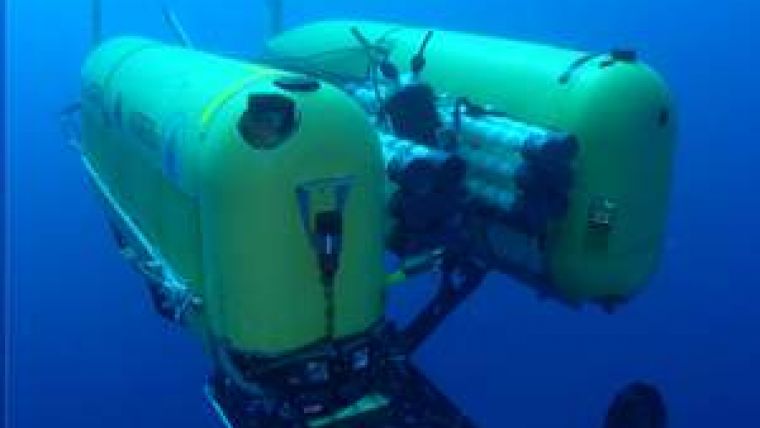Descending to Study Life in Deepest Oceans
Scientists from the Woods Hole Oceanographic Institution (WHOI, USA), University of Hawaii, Whitman College and international colleagues are conducting the first systematic study of life in the deepest marine habitat on Earth: ocean trenches. On 26 March 2012, filmmaker James Cameron became the first person to make a solo dive to the deepest part of the ocean in his submersible, the Deepsea Challenger.
The team was awarded a USD1.4 million collaborative grant from the National Science Foundation for a three-year programme of studies in ocean trenches whose depths range from 19,685 to 36,089 feet (6,000 to 11,000 metres), known as the hadal zone.
Due to the extreme pressures of these deep-sea environments and the technical challenges involved in reaching them, ocean trenches among the least-explored environments on the planet.
The programme takes advantage of recent advances in imaging and collecting technology, and the sampling and exploration capabilities of the deep-diving Hybrid Remotely Operated Vehicle Nereus, which explored Earth’s deepest trench, the Mariana, in 2009, to provide new and unprecedented access to the deepest parts of the ocean floor.
The Hadal Ecosystem Studies (HADES) programme includes international collaborators at the University of Aberdeen (UA) in Scotland, UK, National Institute of Water and Atmospheric Research (NIWA) in New Zealand, and The National Oceanography Centre (NOC) at the University of Southampton, UK.
The work will begin in 2013 at the Kermedec Trench, off the northeastern tip of New Zealand's North Island, and will later include expeditions to the Mariana Trench near the island of Guam in the west Pacific.
At 750 miles long and 32,963 feet (10,047 metres) deep at its deepest, Kermedec is one of the coldest trenches in the world due to the inflow of deep-water originating from Antarctica.
The 2013 expedition will build on recent studies of the Kermadec Trench by HADES programme collaborator Alan Jamieson at UA’s Oceanlab and colleagues at NIWA and the University of Tokyo. Using a free-falling autonomous baited camera system, the research team documented many new species of animals in the Kermadec and other trenches around the Pacific Rim in the past few years.
With icy temperatures, no sunlight and intense pressures, ocean trenches provide a hostile environment for living things. Once thought to be devoid of life, trenches may actually be home to many unique species. For one reason, food is plentiful there. Organic material in the ocean gets moved by currents and pulled down into the trenches.
In addition to looking at how food supply varies at different depths both in the trench and in the abyssal plain,flat areas of the seafloor usually found at depths between 3,000 and 6,000 metres, the research team will be investigating the role energy demand and metabolic rates of trench organisms plays in the community structure and how it differs from shallow water relatives.
Scientists aren’t sure if the animals adjust their requirements strictly to match the food supply or if other factors are at work. Some studies, by Drazen and others, suggest the declines in metabolism stop below about 1,000 metres while food supply (phytoplankton in surface waters) continues to decline with depth.
The animals that have been previously studied were almost all from depths less than 2,000 metres and in areas where both food supply and light decline with depth.
The HADES programme will utilise the deep-diving Hybrid Remotely Operated Vehicle Nereus (image), which was developed by a team of engineers at WHOI. First conceived in 2000, it took nine years to design and build the vehicle.
Nereus was the first vehicle to explore the Mariana Trench since 1998, when the Japan Agency for Marine-Earth Science & Technology’s remotely operated vehicle (ROV) Kaiko made a series of dives there. Kaiko was lost at sea in 2003, and no other ROV was capable of reaching full ocean depths until the development of Nereus.
In October of 2009, researchers successfully used Nereus to investigate hydrothermal vents along the Cayman Trough—the deepest point in the Caribbean Sea with a maximum depth of 25,217 feet (7,686 metres).
The deep-diving, unmanned vehicle can operate either as an autonomous, free-swimming robot for wide-area surveys, or as a tethered vehicle for close-up investigation and sampling. The vehicle will allow HADES programme researchers to gather high definition video along the trench axis, as well as recover organisms and sediment samples.
It was no coincidence that an international gathering on ocean trench studies was held in 2010. 23 January 2010 marked the 50th anniversary of the pioneering dive to Challenger Deep in the Mariana Trench by Jacques Piccard and Don Walsh in the U.S. Navy-operated bathyscaphe Trieste.














